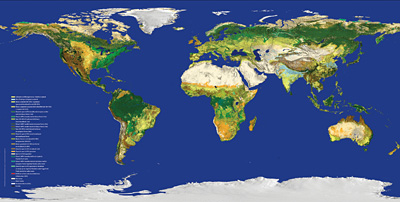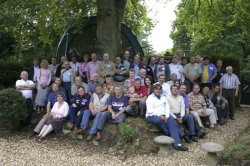Discovery's Launch No Earlier Than Dec. 17
Wed, 24 Nov 2010 04:37:40 PM GMT-0430
NASA managers have targeted space shuttle Discovery's launch for no earlier than Dec. 17. Shuttle managers determined more tests and analysis are needed before proceeding with the STS-133 mission. The launch status meeting planned for Monday, Nov. 29, has been postponed and will be rescheduled.
The Program Requirements Control Board reviewed on Wednesday repairs and engineering evaluations associated with cracks on two 21-foot-long, U-shaped aluminum brackets, called stringers, on the shuttle's external tank. Managers decided the analysis and tests required to launch Discovery safely are not complete. The work will continue through next week.
The next status review by the PRCB will be Thursday, Dec. 2. If managers clear Discovery for launch on Dec. 17, the preferred time is about 8:51 p.m. EST.
STS-133: Delivering the Future10.26.10
Space is about to get a little more futuristic.
Included in the cargo that soon will be arriving at the International Space Station is Robonaut 2, a robotic astronaut. Robonaut 2 will be flying to the station on the STS-133 space shuttle mission, which is scheduled to be the final flight of Discovery.
Robonaut 2 won't be the first robot on the space station. The orbiting lab's robotic population already includes everything from a variety of robotic arms outside the station to Dextre, a robot that can perform spacewalk tasks, to the bowling-ball-sized SPHERES that can fly through the station.
One thing that makes Robonaut 2 unique, however, is that it is designed to look like a human being. Robonaut 2 very closely resembles the upper half of a person, right down to fingers that move like those on a human hand. Engineers have tested Robonaut 2 extensively on Earth; the initial purpose of the robot's time on the space station will be to continue that testing in a space environment.
Robonaut 2 is only one part of the cargo being delivered to the space station on Discovery's final scheduled flight. The space shuttle will be carrying Leonardo, a permanent multipurpose module. Leonardo has flown to the station several times as a cargo container, but this time the module will be left behind as a permanent part of the space station. Discovery also will be delivering extra parts to the station so that they will be available if they are needed in the future.
STS-133 will be the 39th flight of the space shuttle Discovery. Discovery first flew in August 1984. The orbiter is named after four sea vessels, primarily the HMS Discovery that was sailed in expeditions by explorer James Cook. Highlights of the shuttle Discovery's history include launching the Hubble Space Telescope in 1990 and conducting the three Return to Flight missions after the Challenger and Columbia disasters. Discovery has flown more than any other orbiter.
Commanding Discovery for the STS-133 mission will be astronaut Steven Lindsey, who will be making his fifth spaceflight. He commanded two previous missions to the space station, STS-104 in 2001 and STS-121 in 2006. The mission's pilot is Eric Boe. He previously flew on STS-126 in 2008, which delivered new living quarters to the space station.
Mission specialists on STS-133 will be Alvin Drew, Michael Barratt, Tim Kopra and Nicole Stott. Drew previously visited the space station on STS-118 in 2007. Barratt served as a member of the International Space Station's crew in 2009, but he will be making his first flight on the shuttle on STS-133. Kopra flew on the STS-127 mission in 2009 and stayed on the space station as a crew member for two months, returning home on STS-128. Stott switched places with Kopra, riding up to the station on STS-128 and returning to Earth on STS-129 after 91 days in space.
The STS-133 mission is an important step in preparing for the future of spaceflight. NASA is working to carry out a long-term plan that will lead to human exploration of the solar system. Currently, NASA is focused on completing the International Space Station before the shuttle fleet's retirement, planned for 2011. The station is an important platform for learning how to live and work in space and will be vital to exploration as human space travel extends farther from Earth.
NASA is committed to building strategic partnerships and links between science, technology, engineering and mathematics formal and informal educators. Through hands-on, interactive educational activities, NASA is engaging students, educators, families, the public and all agency stakeholders to increase scientific and technological literacy in the United States.




















 Members of the STS-133 crew are (from left) Mission Specialists Alvin Drew and Nicole Stott, Pilot Eric Boe, Commander Steve Lindsey, and Mission Specialists Michael Barratt and Tim Kopra. Image Credit: NASA
Members of the STS-133 crew are (from left) Mission Specialists Alvin Drew and Nicole Stott, Pilot Eric Boe, Commander Steve Lindsey, and Mission Specialists Michael Barratt and Tim Kopra. Image Credit: NASA Updates on Robonaut 2's stay on the space station will be posted on Twitter. Image Credit: NASA
Updates on Robonaut 2's stay on the space station will be posted on Twitter. Image Credit: NASA The design of the STS-133 mission patch symbolizes the end of Discovery's operational life as an orbiter. Image Credit: NASA
The design of the STS-133 mission patch symbolizes the end of Discovery's operational life as an orbiter. Image Credit: NASA


















